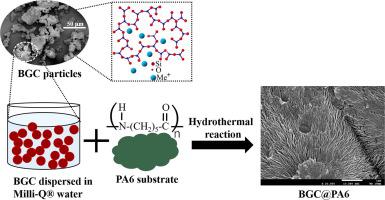Materials & Design ( IF 7.6 ) Pub Date : 2021-09-06 , DOI: 10.1016/j.matdes.2021.110094 Abdalla Abdal-hay 1, 2 , Faheem A. Sheikh 3 , Ahmed N. Shmroukh 2 , Hamouda M. Mousa 2 , Yu-Kyoung Kim 4 , Saso Ivanovski 1

|
The osteoinductivity of bioactive glass ceramics (BGCs) is dependent on their ability to effectively interact with the surrounding physiological environment and influence the fate of target cells; however, masking and poor dispersion can negatively influence bioactivity. Here, we address this problem via a simple fabrication method of assembling highly ordered and aligned arrays of BGC nanoneedle-like structures (@) on the outer surface of various polyamide 6 (PA6) substrates (casted film, 3D printing filaments, electrospun fibre mats) by ion dissociation. The staggered-like nanoneedles of BGC@PA6 substrates with excellent uniform dispersion showed favourable cell viability, proliferation, and spreading of MC3T3 osteoblast-like cells. Moreover, the immobilized BGC nanoneedles induced osteogenic differentiation and accelerated the expression of late osteoblast marker genes, compared to the control group. Furthermore, the BGC@PA6 composite showed high affinity for bone-like apatite formation when incubated in physiological body fluids. These findings suggest that the unique dispersion of BGCs@PA6 substrates with nanostructure features make them attractive candidates for bone tissue regeneration and open avenues for future investigation into exploiting these properties for bone tissue engineering. Importantly, this work provides a novel concept for in-situ immobilization of BGC with distinctive topographical features onto polymer substrates simulating natural bone structure.
中文翻译:

用于骨组织再生的生物活性玻璃陶瓷@2D 和 3D 聚酰胺聚合物基材的固定
生物活性玻璃陶瓷(BGCs)的骨诱导性取决于它们与周围生理环境有效相互作用并影响靶细胞命运的能力;然而,掩蔽和差的分散会对生物活性产生负面影响。在这里,我们通过一种简单的制造方法来解决这个问题,即在各种聚酰胺 6 (PA6) 基材(流延膜、3D 打印长丝、电纺纤维垫)的外表面上组装高度有序和对齐的 BGC 纳米针状结构阵列(@) ) 通过离子离解。具有优异均匀分散性的 BGC@PA6 基材的交错状纳米针显示出良好的 MC3T3 成骨细胞样细胞的细胞活力、增殖和扩散。而且,与对照组相比,固定化的 BGC 纳米针诱导成骨分化并加速晚期成骨细胞标记基因的表达。此外,BGC@PA6 复合材料在生理体液中孵育时对骨样磷灰石形成具有高亲和力。这些发现表明,具有纳米结构特征的 BGCs@PA6 底物的独特分散性使其成为骨组织再生的有吸引力的候选者,并为未来研究利用这些特性进行骨组织工程开辟了道路。重要的是,这项工作为 这些发现表明,具有纳米结构特征的 BGCs@PA6 底物的独特分散性使其成为骨组织再生的有吸引力的候选者,并为未来研究利用这些特性进行骨组织工程开辟了道路。重要的是,这项工作为 这些发现表明,具有纳米结构特征的 BGCs@PA6 底物的独特分散性使其成为骨组织再生的有吸引力的候选者,并为未来研究利用这些特性进行骨组织工程开辟了道路。重要的是,这项工作为将具有独特地形特征的 BGC原位固定到模拟天然骨骼结构的聚合物基材上。











































 京公网安备 11010802027423号
京公网安备 11010802027423号